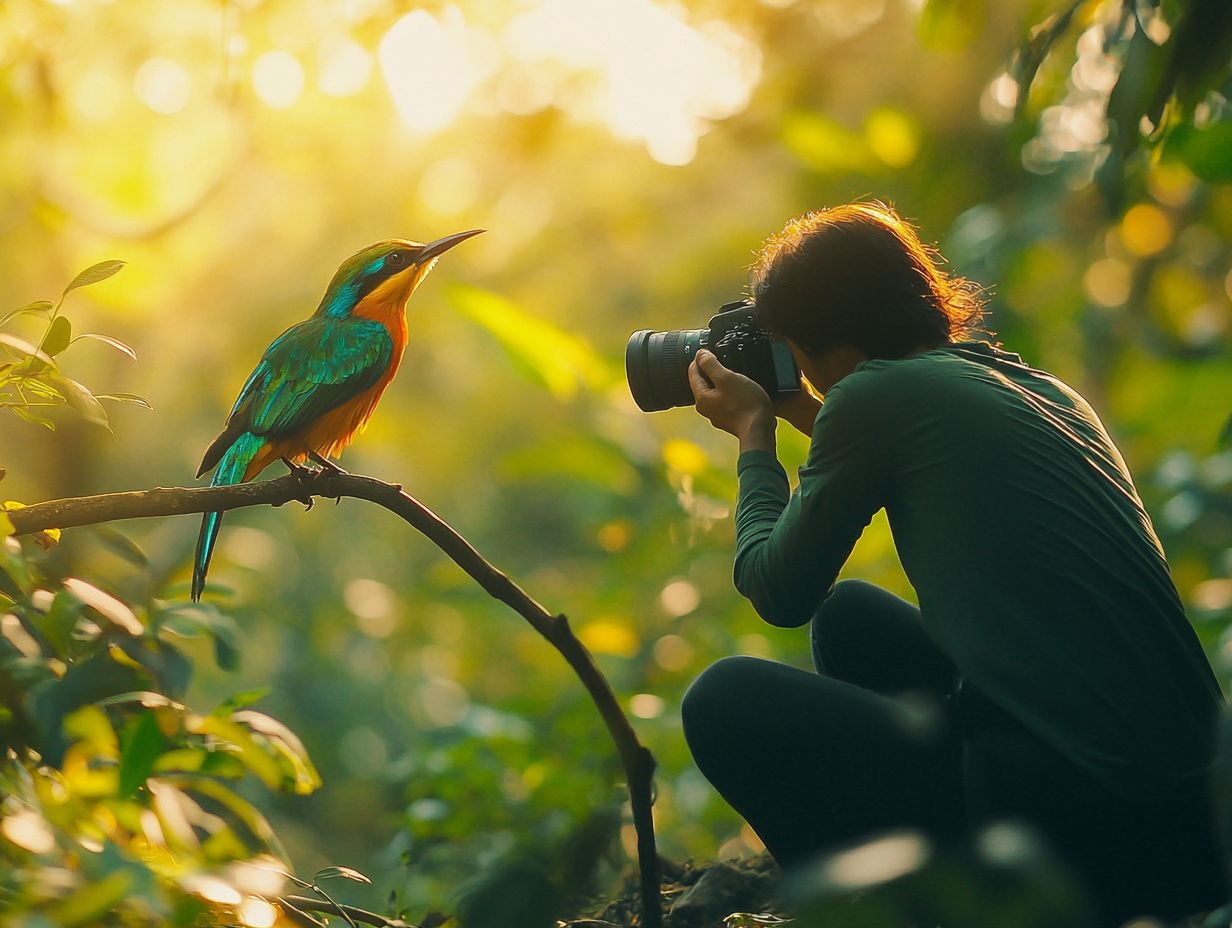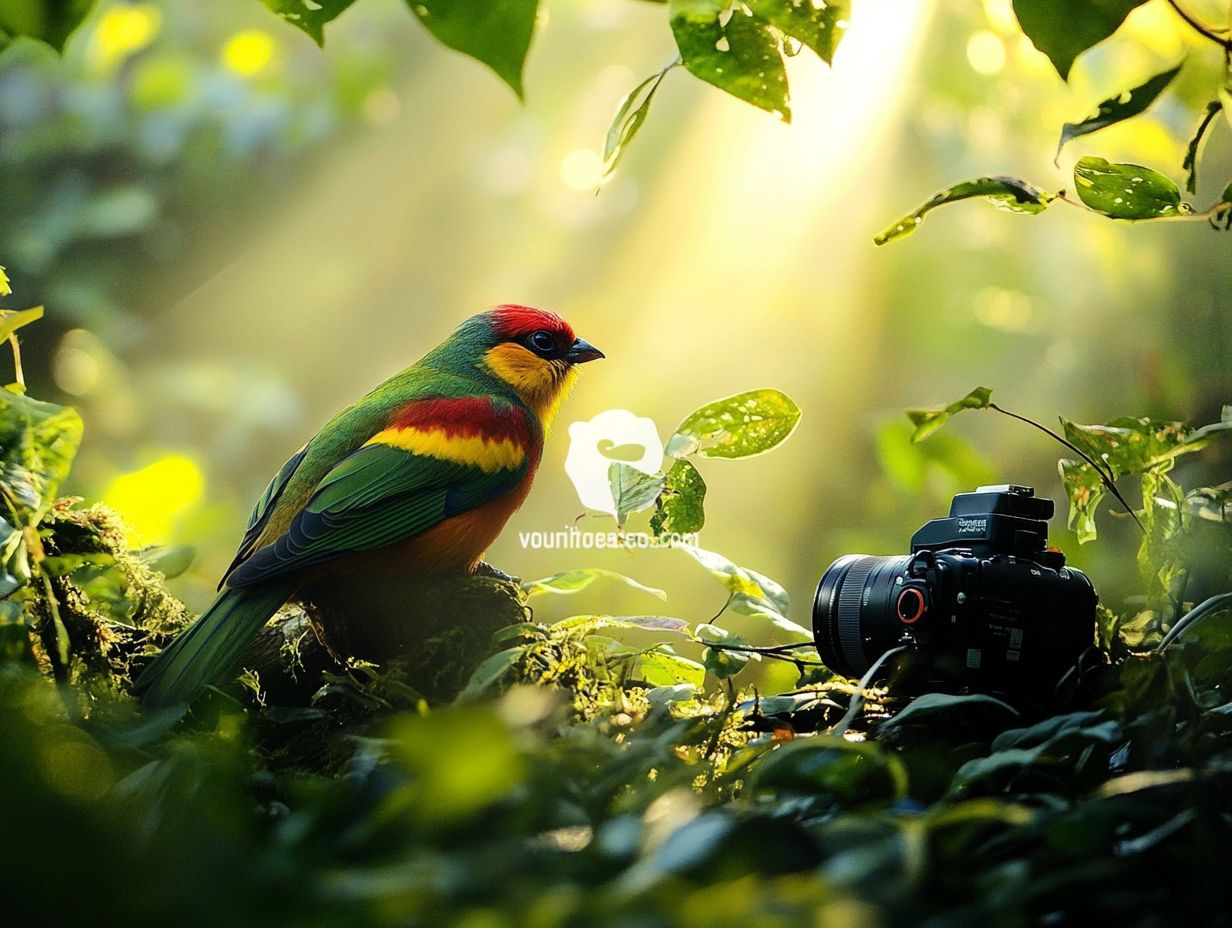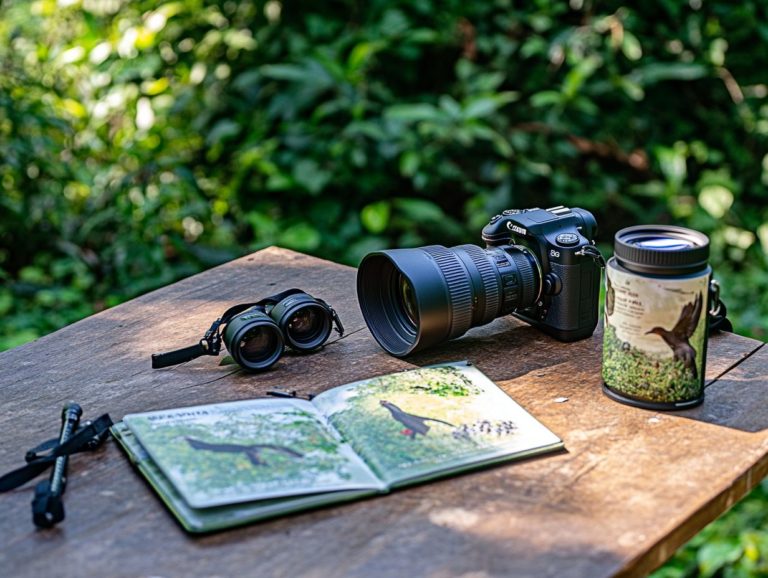The Best Bird Photography Techniques for 2024
Bird photography presents a captivating fusion of challenge and beauty, inviting you to capture the wonders of avian life.
Whether you re just starting out or have years of experience, excelling in bird photography requires a solid understanding of your subject, the right gear, and a keen eye for composition.
This guide will walk you through essential techniques from using natural light effectively to respecting the delicate balance of wildlife ensuring you’re ready to elevate your bird photography in 2024.
Prepare to explore, experiment, and enjoy the journey ahead!
Contents
- Key Takeaways:
- 1. Understanding Your Subject
- 2. Choosing the Right Equipment
- 3. Mastering Composition
- 4. Utilizing Natural Light
- 5. Patience Is Key
- 6. Using Different Perspectives
- 7. Being Mindful of the Background
- 8. Capturing Action Shots
- 9. Experimenting with Different Settings
- 10. Post-Processing Techniques
- 11. Understanding Bird Behavior
- 12. Getting Close to Your Subject
- 13. Using a Tripod or Monopod
- 14. Being Respectful of Wildlife
- 15. Practicing and Being Persistent
- Frequently Asked Questions
- What are the best bird photography techniques for 2024?
- How can I improve my bird photography skills in 2024?
- What equipment will I need for bird photography in 2024?
- How can I capture unique and creative bird photos in 2024?
- Are there ethical considerations for bird photography in 2024?
- Will there be any new trends or advancements in bird photography in 2024?
Key Takeaways:

- Understanding your subject is important for capturing great bird photos. Take time to research and observe their behavior to anticipate their movements and expressions.
- Choose the right equipment, such as a fast lens and a camera with a high shutter speed, to capture birds in action.
- Master composition, use natural light, and be mindful of the background to create visually appealing bird photos.
1. Understanding Your Subject
Knowing your subject is vital in bird photography, especially when capturing the behaviors and characteristics of different bird species. This knowledge leads to better wildlife photography experiences.
Whether you re photographing birds in flight or those perched gracefully, understanding their habits and habitats will help you take stunning images that reflect their essence.
Grasping the details of bird behavior like feeding patterns or migration routes not only enhances your birdwatching experience but also helps you identify different species. Knowing where specific birds prefer to nest or forage can greatly improve your chances of spotting them.
Being aware of your surroundings contributes to more dynamic compositions and natural interactions, allowing each photograph to tell a unique story. Patience is essential; spending time in one location increases your familiarity with local birdlife, paving the way for more genuine and striking shots.
By incorporating these practices into your photography routine, you can transform ordinary snapshots into true artistic representations of nature.
2. Choosing the Right Equipment
Selecting the right equipment is crucial in bird photography, as it directly affects your ability to capture breathtaking images of various species, whether you’re photographing seabirds in flight or elusive perch birds.
The ideal focal length often is a key consideration, along with a solid understanding of different lens categories and their weights, ensuring you have the best photography gear for your needs.
When considering camera options, models like the Nikon Z9, Canon R5, and Sony A1 excel with their remarkable autofocus capabilities and rapid shooting speeds essentials for tracking those quick movements in birds. Understanding what sets these cameras apart will help you make a more informed choice.
Choosing the right lenses is also important; for instance, a 400mm lens lets you capture stunning close-ups of larger birds, while a 200mm lens may be better for smaller species.
Mastering camera settings like shutter speed, aperture, and ISO can greatly enhance the clarity and detail of your shots, ensuring you get the most from your shooting experience.
So grab your camera and start exploring the wonderful world of birds today!
3. Mastering Composition
Mastering composition is essential in bird photography. It allows you to create stunning images that capture attention and highlight your subjects.
Your approach to composition can turn ordinary snapshots into a mesmerizing work of art. For instance, the rule of thirds guides the viewer’s eye to focal points, while leading lines create pathways that draw attention to the birds. Framing techniques offer a structured approach, inviting your audience to explore the image more deeply.
The choice of background is equally vital. A beautiful backdrop makes your subject shine, whereas a cluttered one can distract and dilute the overall message. By thoughtfully considering these elements, you can craft images that not only tell a compelling story but also evoke genuine emotion.
4. Utilizing Natural Light
Utilizing natural light effectively is crucial in bird photography. It can improve the quality of your images, adding depth and vibrancy that artificial lighting simply can’t match. By understanding how various light conditions influence your photography, you can capture stunning wildlife shots that showcase birds in their natural habitats.
Consider the time of day in your planning. Morning and late afternoon light, commonly known as the golden hour, casts a warm glow that enhances your subjects beautifully. Overcast skies also offer the advantage of even, diffused lighting, minimizing harsh shadows and perfect for bird portraits.
When you’re outdoors, you need to adapt to changing light conditions. Adjust your settings as the sun shifts or clouds drift to ensure your technique complements the natural allure of your surroundings. Pay close attention to the direction and color of light, as these factors can significantly affect your composition and the mood of your photographs.
Stay observant and ready to capture those breathtaking moments in bird photography.
5. Patience Is Key

Patience is a cornerstone of bird photography. Waiting for that perfect moment often leads to the most rewarding wildlife encounters and breathtaking images. This skill not only enhances your photography experience but also deepens your connection with nature.
Investing time in observing and understanding bird habits can dramatically improve your chances of capturing that exceptional shot. Stay quiet and move with care to get closer without startling your subjects.
Embracing stillness nurtures mindfulness and sharpens your ability to recognize opportune moments. This results in more compelling compositions. Approaching bird photography with a patient mindset fosters a deeper appreciation for the intricate dynamics of avian life, enriching your understanding of their behaviors while refining your photography skills.
6. Using Different Perspectives
Exploring different perspectives in bird photography can profoundly enhance the storytelling aspect of your images. It allows you to craft unique compositions that highlight the subject’s character and habitat. By experimenting with various angles and viewpoints, you can capture the essence of wildlife photography in ways that standard shots often miss.
For instance, try a low-angle shot to create a sense of dominance and grandeur. This can make the bird appear larger than life against a dramatic sky. Conversely, high-angle shots provide a broader view of the habitat, showcasing how the bird interacts with its environment.
Each perspective elevates visual appeal and conveys distinct emotions and narratives. Imagine how a low-angle shot of an eagle soaring against the sun evokes feelings of freedom and majesty, while a high-angle perspective reveals the intricate details of its nest, weaving a compelling story of nurturing and survival.
7. Being Mindful of the Background
Being mindful of the background in bird photography is essential; it can truly make or break the overall composition of your images, shaping how the subject is perceived within its environment. Thoughtful consideration of backgrounds enhances storytelling in wildlife photography and draws attention to the stunning bird species you aim to capture.
The choice of background significantly influences both the visual appeal of your photograph and the emotional tone it conveys. Using color contrast is a powerful technique. For instance, a vividly colored bird against a muted backdrop creates a striking visual impact!
Background textures also play a crucial role; they can either complement or compete with your primary subject. A soft, blurred texture typically enhances focus on the bird, while a busy environment might distract the viewer from the true star of the show.
Ultimately, understanding how varied backgrounds interact with your subject is vital for elevating the viewer’s experience of your images.
8. Capturing Action Shots
Capturing action shots in bird photography, especially of birds in flight, requires a sharp understanding of shutter speed and continuous focus modes. It s all about freezing the moment while conveying the dynamism of wildlife photography. Master these photography techniques, and you’ll create breathtaking images that capture the essence of birds in motion!
Using a fast shutter speed ideally at least 1/1000th of a second is essential for freezing swift subjects, allowing the details of feathers and wing movements to shine through. Focus on your avian subjects with continuous focus modes that help keep moving objects in focus.
Framing your subject with open space in the direction they re flying adds a sense of freedom and enhances the narrative of your photograph. Proper composition tips will help you create more dynamic images. Paying attention to these elements will elevate your bird photography portfolio to new heights!
9. Experimenting with Different Settings
Experimenting with various camera settings is crucial for any photographer, especially in bird photography. The best settings change based on light and bird behavior. Understanding how to adjust for different weather conditions and lighting will give you better images.
For example, when shooting in bright daylight, increase the shutter speed to freeze motion while lowering the ISO to reduce noise in your images. In low-light situations, raise the ISO and widen the aperture to let in more light.
Using mobile hides can enhance your experimentation, giving you different perspectives and closer encounters with your subjects without causing disruption. These setups are particularly effective for capturing perch birds.
Using techniques like panning or backlighting helps you adapt creatively to different environments. Don t miss your chance to capture that perfect shot!
10. Post-Processing Techniques

Post-processing techniques are essential in bird photography. They help refine your images and enhance details, revealing the true beauty of wildlife that might not be fully captured in-camera.
Utilizing effective editing techniques can elevate your wildlife photography. This allows you to create visually striking images that resonate with your audience.
By using tools like Lightroom or Photoshop, you can apply color correction to adjust the colors in your photos. This makes the vibrant hues of feathers look more natural. Understanding the different lens categories involved can also assist in achieving the best results during editing.
Cropping directs the viewer s gaze to the subject, banishing distractions. Meanwhile, sharpening techniques bring out the intricate details that make each bird unique.
Finding the right balance is crucial in these adjustments. Over-editing can lead to artificial images that undermine the subject’s authenticity. Your aim should always be to enhance the image while preserving its integrity. This way, viewers feel as though they are experiencing the moment right alongside you.
11. Understanding Bird Behavior
Understanding bird behavior is crucial for success in bird photography. It enables you to anticipate their actions and seize the perfect moments for ethical encounters with various species.
This knowledge not only elevates the quality of your images but also underscores the importance of ethical considerations in wildlife photography, contributing to overall wildlife conservation.
By observing intricate mating rituals and feeding habits, you gain insights into the optimal times and locations for your sessions. Recognizing patterns of movement and specific behaviors, like courtship displays or communal feeding, can significantly enhance your chances of capturing breathtaking shots.
Embracing these dynamics fosters a respectful approach. It enables you to minimize disturbance to the birds natural routines. Participating in wildlife conservation makes your experiences more rewarding, benefiting both the wildlife and enriching your experience.
12. Getting Close to Your Subject
Getting close to your subject is essential in bird photography. It allows you to capture intimate details and create powerful wildlife encounters that resonate within your photographic experiences.
Tools like binoculars or mobile hides can facilitate this closeness. They help you minimize disturbances to the birds, particularly useful for spotting birding hotspots.
If you want to enhance your ability to approach birds, employing camouflage is crucial. Dressing in earthy tones or using natural materials helps you blend into the environment, reducing the likelihood of startling your feathered friends.
Patience plays a vital role in this art. Sitting quietly and letting the birds acclimate to your presence can lead to stunning results. Scouting locations with binoculars aids in identifying various bird species and planning angles and photography compositions before you even arrive on-site with your camera.
This thoughtful approach ensures you’re prepared. It also shows respect for your avian subjects. Keeping in mind the ideal settings for your camera will enhance your chances of success.
Are you ready to enhance your bird photography skills? Don’t miss the chance to capture breathtaking shots get started now!
13. Using a Tripod or Monopod
Using a tripod or monopod is crucial in bird photography, especially when working with heavy lenses. These tools deliver the stability necessary to capture crisp images while minimizing fatigue during long photography sessions. Understanding lens weight and its balance is essential. Investing in quality gear can elevate your entire shooting experience, making it easier to track birds in flight or perched nearby.
The benefits of these support tools extend beyond stability; they offer remarkable versatility for various shooting situations. Knowing the different types of camera lenses helps you choose the right tool for the job. A tripod is ideal for stationary setups that require long exposures, while a monopod allows for quick adjustments as birds move about. These tools also lighten the load of heavy lenses, keeping you comfortable during long hours in the field.
When selecting the right equipment, consider factors like the weight of your lens and the shooting conditions you expect. Understanding gear considerations helps you make informed choices, ensuring your support meets the unique demands of your photography.
14. Being Respectful of Wildlife
Being respectful of wildlife is a fundamental principle in bird photography. This approach nurtures conservation efforts and safeguards the well-being of the birds you wish to capture. It leads to more enriching photography experiences and contributes to wildlife conservation.
Grasping the ethical considerations involved establishes a deeper connection with nature while minimizing your impact on bird behavior and their habitats. Enhancing your environmental awareness is key to responsible wildlife photography.
By maintaining an appropriate distance and avoiding unnecessary disruptions, you significantly reduce stress on your avian subjects. Ethical practices are essential for protecting natural ecosystems, enhancing your photographic outcomes while preserving these environments.
Prioritizing habitat protection actively contributes to conservation efforts, fostering a sustainable environment for future generations of both wildlife and photographers. Your commitment to wildlife conservation will make a difference!
15. Practicing and Being Persistent

Practicing and staying persistent are essential for improving your bird photography. Consistent effort leads to more successful wildlife encounters and enhances your overall photography skills. Embracing the challenges of capturing elusive bird species deepens your appreciation for nature.
To excel, integrate regular practice into your routine. Join local birdwatching groups or use bird identification apps like eBird to broaden your knowledge. These tools sharpen your observational skills and help you determine when and where to find specific species. Remember, patience is crucial; many remarkable wildlife moments unfold quietly and unexpectedly.
With a determined mindset, you can navigate unpredictable weather and erratic bird behavior, leading to stunning captures that tell compelling stories of avian life. Consider using camera recommendations to better prepare for these challenges.
Frequently Asked Questions
What are the best bird photography techniques for 2024?
Discover the top bird photography techniques for 2024 that blend tradition with cutting-edge technology, tailored to specific photography styles.
How can I improve my bird photography skills in 2024?
Practice regularly. Study bird behavior and habitats. Stay updated with the latest photography tips.
What equipment will I need for bird photography in 2024?
You will need a high-quality camera with a long lens. A tripod or monopod will help with stability, along with protective gear like rain covers.
How can I capture unique and creative bird photos in 2024?
Experiment with different angles and lighting. Be patient to capture rare moments, especially birds in flight.
Are there ethical considerations for bird photography in 2024?
Always prioritize the well-being of birds. Respect their space and follow local conservation laws.
Will there be any new trends or advancements in bird photography in 2024?
Exciting advancements are on the horizon, like improved camera technology and new techniques. This will enhance both wildlife photography and awareness.






